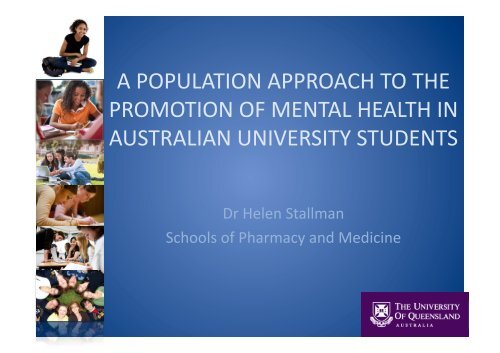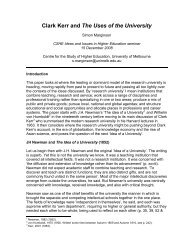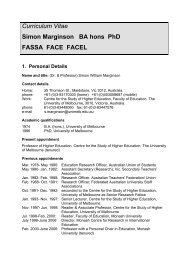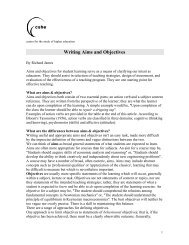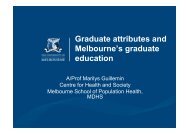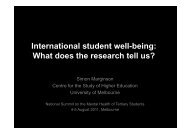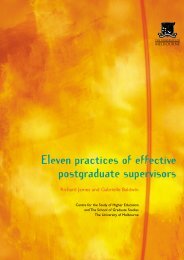PPT - Centre for the Study of Higher Education
PPT - Centre for the Study of Higher Education
PPT - Centre for the Study of Higher Education
- No tags were found...
You also want an ePaper? Increase the reach of your titles
YUMPU automatically turns print PDFs into web optimized ePapers that Google loves.
A POPULATION APPROACH TO THE PROMOTION OF MENTAL HEALTH IN AUSTRALIAN UNIVERSITY STUDENTS Dr Helen Stallman Schools <strong>of</strong> Pharmacy and Medicine
Frequent stressors <strong>for</strong> students N = 2596 ProcrasPnaPon Academic/coursework demands <strong>Study</strong>/life balance Finances and money problems Frequently or Always 65.8% 57.7% 52.1% 51.5% (Stallman & Hurst, 2011)
Frequent stressors <strong>for</strong> students N = 2596 Language/cultural issues DiscriminaPon Childcare Sexual orientaPon issues Frequently or Always 5.3% 5.1% 4.4% 2.2% (Stallman & Hurst, 2011)
Prevalence Psychological Distress 80 70 60 50 %40 30 20 Low Moderate High Very high 10 0 2008 (N = 6449) 2009 (N = 2593) NHS (2007-‐08) d = .09
Changes during semester 25 20 15 10 Week 2 Week 12 5 0 Stress Distress Sleep problems Alcohol problems (Stallman, Hurst, & Appleton, in prep)
Impact <strong>of</strong> Distress on GPA 5.6 5.5 5.4 5.3 5.2 5.1 5 4.9 4.8 Low Moderate High Very High Level <strong>of</strong> Distress
Predictors <strong>of</strong> Distress 35% <strong>of</strong> psychological distress can be explained by negaPve thinking paberns – Coping self-‐efficacy – PerfecPonism O<strong>the</strong>r major predictors are – Sleep problems 10% – Stress 5% – University Connectedness 14.5%
Policy and Funding University Individual
Policy and Funding University Individual
Birth cohort increases in psychopathology college students 1938–2007 (N=63 706) • NarcissisPc, self-‐centred, and anPsocial, and ogen do not follow <strong>the</strong> rules and standards <strong>of</strong> society • Ogen fight with family members or authority figures • SensiPve and senPmental • UnrealisPc posiPve self-‐appraisal, overacPvity, & low self control Twenge et al, 2009
Policy and Funding University Individual
University MarkePng
Helpseeking %50 45 40 35 30 25 20 15 10 5 0 Overall Moderate High Very high Level <strong>of</strong> Distress
Preven(on is <strong>the</strong> only sustainable method <strong>for</strong> reducing <strong>the</strong> burden caused by mental health problems (WHO, 2004) Universal Agercare (including rehabilitaPon)
Resilience is <strong>the</strong> capacity to adapt well over Pme to life-‐changing or stressful situaPons
PrevenPon Programs Aimed at empowering students to: Be resourceful, IdenPfy and build on strengths, Solve problems Manage unpleasant emoPons.
Universal/selected IntervenPons • Thedesk -‐ Online Resilience program • The Learning Thermometer • Staying on Track • Student Wellbeing Program
Homepage
Learning Thermometer Project
The Learning Thermometer • Brief survey weeks 1, 4, 8, & 13 • Reflect upon – Progress towards learning outcomes – Usefulness <strong>of</strong> resources and environment to learning – Student goals – Wellbeing
Staying on Track – within curriculum seminar PosiAve Self-‐Talk Managing Stress Taking AcAon RealisAc ExpectaAons Balance Connectedness
Targeted IntervenPon Low intensity intervenPon • Screen all students who abend health service • Personalised ‘low intensity’ plan • Guided self-‐help Aims to Increase <strong>the</strong> idenPficaPon and access to evidence-‐based treatments <strong>for</strong> university students experiencing psychological distress.
ImplicaPons <strong>for</strong> UniversiPes • Focus on prevenPon is important • Access to resources <strong>for</strong> more students • Needs addressed sooner...less intrusive More resilient students Beber student graduate capabiliPes Challenges POLICY -‐-‐-‐ CURRICULUM -‐-‐-‐ INTERVENTION
References Stallman, H. M. (2008). Prevalence <strong>of</strong> psychological distress in university students: implicaPons <strong>for</strong> service delivery. Australian Family Physician, 37(8), 673-‐677. Stallman, H. M., & Shochet, I. M. (2009). Prevalence <strong>of</strong> mental health problems in university general pracPces. Australian Psychologist, 44(2), 122–127 Stallman, H. M. (in press). Psychological distress in university students: a comparison with general populaPon data. Australian Psychologist. Ryan, M. L., Shochet, I. M., & Stallman, H. M. (2010). Online resilience intervenPons might engage psychologically distressed university students who are unlikely to seek <strong>for</strong>mal help. Advances in Mental Health, 9(1). Stallman, H. M. (in press). Embedding resilience within <strong>the</strong> terPary curriculum: A feasibility study. <strong>Higher</strong> Educa(on Research and Development. Stallman, H. M., & Hurst, C. P. (2011). EvaluaPon <strong>of</strong> <strong>the</strong> psychometric properPes and clinical uPlity <strong>of</strong> <strong>the</strong> University Stress Scale. Manuscript submiVed <strong>for</strong> publica(on. Khawaja, N., & Stallman, H. M. (in press). A qualita(ve approach to understanding <strong>the</strong> resilience <strong>of</strong> interna(onal students. Stallman, H. M. (in press). A qualitaPve evaluaPon <strong>of</strong> percepPons <strong>of</strong> <strong>the</strong> role <strong>of</strong> compePPon in <strong>the</strong> success and distress <strong>of</strong> law students. <strong>Higher</strong> Educa(on Research and Development. Accepted 12 April 2011. Stallman, H. M. (in press). University counselling services in Australia and New Zealand: AcPviPes, changes, and challenges. Australian Psychologist. Accepted 10 January 2011.


